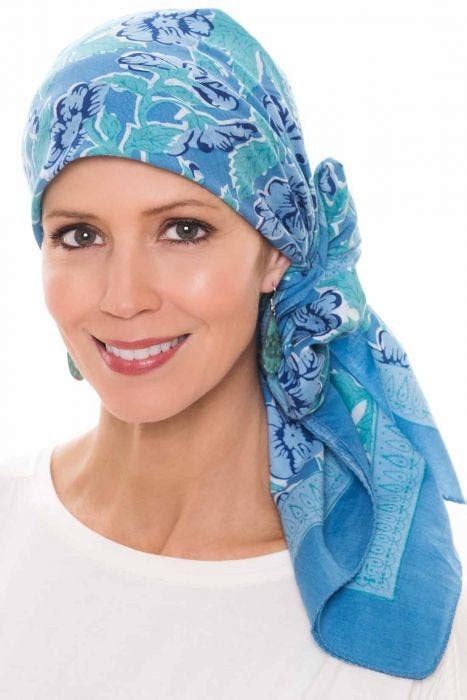Losing your hair due to cancer treatment can be a physically and emotionally challenging experience. Head scarves offer a compassionate and stylish way to regain confidence and find solace during this difficult time. In this comprehensive guide, we explore the world of head scarves, providing practical advice, styling tips, and resources to help you feel comfortable, beautiful, and empowered.

Why Head Scarves Matter: Beyond Aesthetics
- Protect sensitive skin: Chemotherapy and radiation can leave the scalp vulnerable and prone to sunburn, infection, and irritation. Head scarves provide a barrier against the elements.
- Enhance comfort: Scarves can absorb sweat, reduce friction, and minimize pressure on the scalp, providing much-needed comfort during treatment and recovery.
- Boost confidence: Losing your hair can affect your self-esteem, but a carefully chosen and well-styled head scarf can restore a sense of normalcy and boost your confidence.
Benefits of Head Scarves for Women with Cancer
- Supports recovery: Scarves protect the scalp from infection and irritation, aiding in the healing process.
- Provides warmth: Soft and cozy scarves can provide warmth during cold weather or after hair loss.
- Offers privacy: Scarves help you maintain control over how much of your head or hair is visible.
- Reduces stress: The act of choosing and styling a head scarf can be therapeutic, offering a sense of agency and control during a stressful time.
- Empowers women: Head scarves empower women by allowing them to express themselves creatively and regain a sense of identity.
Types of Head Scarves
There is a wide variety of head scarves to choose from, each offering unique features and benefits:
- Pre-tied scarves: Convenient and easy to use, pre-tied scarves come in various styles and fabrics.
- Infinity scarves: These stylish scarves can be worn in different ways, offering flexibility and versatility.
- Square scarves: A classic choice, square scarves can be folded and tied in numerous ways, providing endless styling possibilities.
- Bandanas: Lightweight and moisture-wicking, bandanas are perfect for active women or those who prefer a more casual look.
- Turbans: Providing full coverage, turbans are a comfortable and elegant option that can enhance confidence.
Choosing the Right Head Scarf
Selecting the right head scarf depends on your individual needs and preferences. Consider the following factors:
- Material: Look for soft and breathable fabrics like cotton, silk, or bamboo. Avoid materials that irritate or itch the scalp.
- Size: Ensure the scarf provides adequate coverage for your head and neck. If it’s too small, it may be uncomfortable or fall off; if it’s too large, it can be bulky or overwhelming.
- Style: Choose a scarf that complements your personal style and the occasion. From chic and sophisticated to bohemian and sporty, there’s a scarf for every taste.
- Color: Experiment with different colors to find hues that enhance your complexion and match your wardrobe. Bold prints and patterns can add a touch of personality.
Styling Tips and Tricks
Styling a head scarf can be an art. Here are some helpful tips to get you started:
- Fold and knot: Experiment with different folding and knotting techniques to create unique looks.
- Use accessories: Scarfs, hair clips, or pins can add a touch of glamour or secure the scarf in place.
- Accessorize with jewelry: Statement earrings or a necklace can complement your head scarf and add a touch of sophistication.
- Consider your face shape: Different face shapes suit different scarf styles. For example, an oblong face can benefit from a scarf with volume at the crown, while a round face may look best with a scarf that frames the cheeks.
- Practice makes perfect: Don’t be afraid to experiment with different styles until you find what feels comfortable and looks flattering.
Resources for Women with Cancer
Numerous organizations and resources are available to support women with cancer:
- American Cancer Society: Provides information, resources, and support for cancer patients and their families.
- National Cancer Institute: Offers comprehensive information on cancer treatment, including head scarves and other resources.
- Look Good Feel Better: A non-profit organization that provides beauty and confidence-building services to women undergoing cancer treatment.
- CancerCare: Provides free support, information, and services to cancer patients and their families.
Conclusion
Head scarves are more than just a fashion accessory for women with cancer. They offer comfort, confidence, and a sense of empowerment during a challenging time. By choosing the right scarf and styling it creatively, you can regain your sense of self and face your journey with grace and dignity. Remember, you are not alone, and there are resources available to support you every step of the way.
